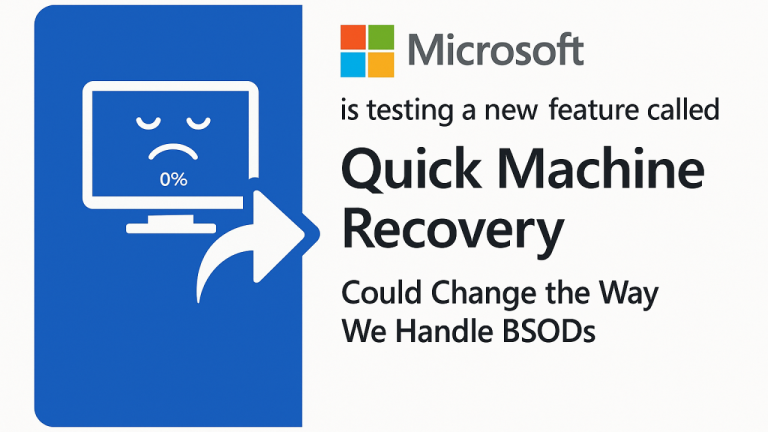For anyone who’s ever stared helplessly at a blue screen of death (BSOD), you know the routine: restart, hope it was a fluke, maybe boot into safe mode, and if that fails, pray Startup Repair miraculously does something (it rarely does).
If you’re in IT, multiply that by dozens—or hundreds—of machines in an environment, and you’ve got a recipe for long nights and frustrated users.
Now, Microsoft is previewing a feature that might finally offer a smarter way forward: Quick Machine Recovery.
What Is Quick Machine Recovery?
Quick Machine Recovery is a new recovery feature being tested in Windows that responds to system crashes caused by misbehaving drivers, faulty updates, or corrupted configurations. The tool works by:
- Connecting to the Internet (Ethernet or Wi-Fi) even in recovery mode
- Automatically sending crash logs and telemetry to Microsoft
- Receiving real-time, tailored recovery actions from Microsoft, which might include:
This means instead of throwing the kitchen sink at a problem or re-imaging the entire machine, the OS will try to understand what’s actually wrong and offer a fix that fits.
Why This Matters
This isn’t just another checkbox feature. It addresses a long-standing pain point that affects IT departments, managed service providers, and end-users alike.
Take the recent CrowdStrike driver incident as an example—one wrong update sent countless machines into blue screen loops. Quick Machine Recovery could, in theory, detect that kind of failure, check Microsoft’s crash signature database, and remove the offending driver or patch before it bricks the machine.
That kind of targeted, intelligent recovery is a game changer for:
- IT support teams trying to reduce downtime
- MSPs managing fleets of client devices
- Businesses relying on device uptime for operations
- Power users who just want their systems back without full reinstalls
A Personal Take — From Someone Who’s Seen Too Many BSODs
Let me be real for a moment: Startup Repair has never worked for me. Not once. At best, it gives you a log file that’s vague and unhelpful. Most of us in the industry treat it like a courtesy step before reformatting.
If Quick Machine Recovery can actually diagnose the issue and apply a real fix, that’s a leap forward—especially if it avoids wiping user data or apps in the process.
That said, I do have one lingering concern: what happens if the network driver is the culprit? If the system can’t get online, it won’t be able to download the fix. Hopefully Microsoft builds in some kind of local fallback or preload mechanism—or at least ensures core networking remains intact during recovery.
Where It Fits in the Bigger Picture
Quick Machine Recovery feels like part of a broader trend where Microsoft is moving toward self-healing systems — a bit of Azure-style resiliency brought down to the local OS level.
It’s reminiscent of the cloud’s “repair before replace” model, and I think we’ll see more of that in endpoint management tools, Intune integrations, and even custom recovery pipelines for enterprises.
For businesses using Microsoft’s ecosystem end-to-end, this feature could be the missing link between “we know what went wrong” and “we fixed it without touching the machine.”
My Take as an IT Professional and Builder
At ALCO USA, we’re constantly deploying tools to automate recovery, optimize endpoint reliability, and reduce hands-on intervention. This kind of native OS feature—especially if it opens to APIs or Intune hooks—could extend the power of our offerings significantly.
Imagine a world where your recovery process isn’t a static image or script—it’s adaptive, dynamic, and backed by Microsoft’s vast telemetry and patching infrastructure. That’s the kind of tech I want powering my clients’ systems.
Final Thoughts
I’m excited to see where this goes. If it’s executed well, Quick Machine Recovery could replace a dozen workarounds and band-aids we’ve been using for years.
Of course, the best-case scenario is still not needing recovery at all—but when things do go wrong, this could mean the difference between 30 minutes of downtime and a full day lost to imaging and setup.
We’ll be watching this one closely.


